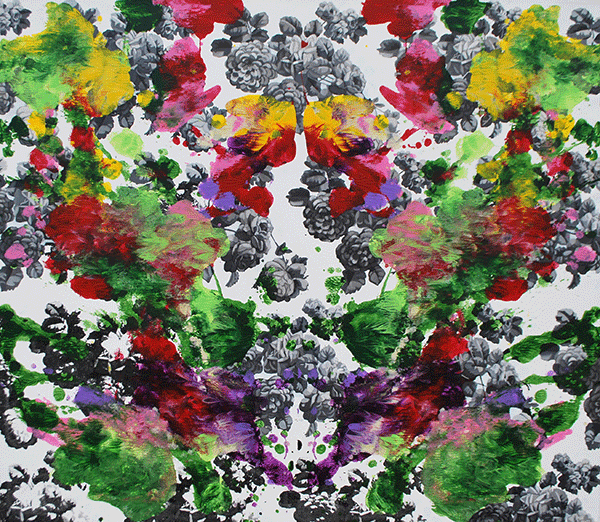Katherine Rohrbacher has been pursuing art her entire life. When she realized she had talent, she dove deep into it in high school. Once she found out that art school not only existed but was also an option for furthering her education, she became even more enamored. “I was motivated to get into [art school]. I actually sold my first piece when I was a senior in high school,” Rohrbacher said via email.
She received her bachelor of fine arts from the School of the Art Institute of Chicago and her master of fine arts from the Leroy E. Hoffberger School of Painting at the Maryland Institute College of Art.
Sometimes looking at a painting or sculpture gives the viewer no insight into the artist’s personality or intent, but Rohrbacher often uses herself as the subject, making those insights easier to see.
“I’ve been known to do a lot of self-portraits,” she said. “My work comes from a highly personal place. In the past, I have created work based on my experience of being adopted and have also made work about having Lupus. Pattern, especially floral patterns, have been constant in my work, and lately I’ve been working purely on floral paintings juxtaposed with Rorschach inkblots as well as digital symbols, creating work about appreciation and perception of beauty,” she said.
Besides painting floral pieces, Rohrbach creates designer oven mitts and cleaning and gardening gloves which she sells on Etsy and at different fairs and events in the Fort Wayne area. She’s also a coach at Curves in New Haven.
“I balance everything by only working at Curves twice a week and by having an at home studio and just working all the time,” she said.
Rohrbacher’s “Left” and “Right,” combine her self-portraits Rorschach elements. Each piece is half of her face, mirrored and given life via the colors and splatterings around her. On “Left” we are given almost a goddess presentation with the purple and dark blue paint up top making a sort of headdress via the paint itself. The yellows and greens along the side frame her face to give a royal feeling.
“Right” presents the right side of the artist’s face, mirrored and with much more smudging of colors. The hair framing her face resembles a nun’s hood, contrasting nicely the royal feeling of “Left.” The deep greens and olives play nicely with the painting’s reds, pinks and teals. Presenting “Left” and “Right” side-by-side illustrates the complexity of self.
“I paint from photos, so when I get an idea for a painting I do what I need to do to get an image of what I want to paint,” she explained. “If I am painting myself, I set up my camera and take photos of myself. I did a series of paintings where I wore different headdresses so I would create the headdresses and then photograph myself wearing them. If I am painting a fox or a bird I just search a bunch of different photos and find the one that has the perfect positioning and look I am going for.
“My last painting … was from a little three-inch photo from a large Classic Roses coffee table book I bought at a garage sale that I turned into a three-foot painting. Once I find an image, I project it onto the canvas or panel that I am using to get a rough sketch of it to begin.”
Rohrbacher’s work is very cohesive, plainly showing her style in each piece. And although the pieces are similar in composition, they can have entirely different moods.
Her pieces “Stop” and “Pause,” for instance, feature similar square formats with centered shapes surrounded by floral arrangements. Both are oil on wood, and the square we’ve come to know as the emblem for “stop” and the two vertical, parallel lines we’ve come to known as “pause” lump these two into the same series. But the mood of each is different.
With “Pause,” the background is black, giving it a darker feeling. Some of the pink flowers are still buds or are in the process of opening up, a reference to the piece’s title. Overall, the work conveys how being stuck between two phases or places can have a shadowy feeling.
One might imagine “Stop” would be even darker than “Pause,” the stopping of things being the all-encompassing metaphor for death. But this piece has a brighter, grayish-blue background and multi-colored flowers in full bloom. There are no buds in sight, and many of the flowers are different types. “Stop,” conveys the notion that the ending of something can be just as beautiful and vibrant as the beginning or middle. This, of course, has many similarities to life, but also to Rohrbacher’s journey through graduate school.
“They always say you will leave grad school creating completely different work than you came in, and I didn’t believe them. I was a figurative painter, and my thesis show was going to be large figurative oil paintings on canvas. But it turns out they were right; my thesis show was glitter pattern paintings on wood with tiny little drawings embedded in them,” she said.
“Being emerged in a small painting program with world class mentors and talented classmates helped to develop my concepts, expand my idea of what art can be and helped me find a way to visually communicate concepts in ways that I never had before. After grad school, I wanted to get back to my roots and found ways to combine my previous figurative background with my new use of pattern and glitter.”
The constant in Rohrbach’s evolving art is her deeply personal style, and that is by design.
“I believe that the most personal is the most universal, and even making personal work can reach other people,” she said. “Because when it comes down to it, we are all going through the same stuff. The best feeling in the world is knowing you are not alone.”
